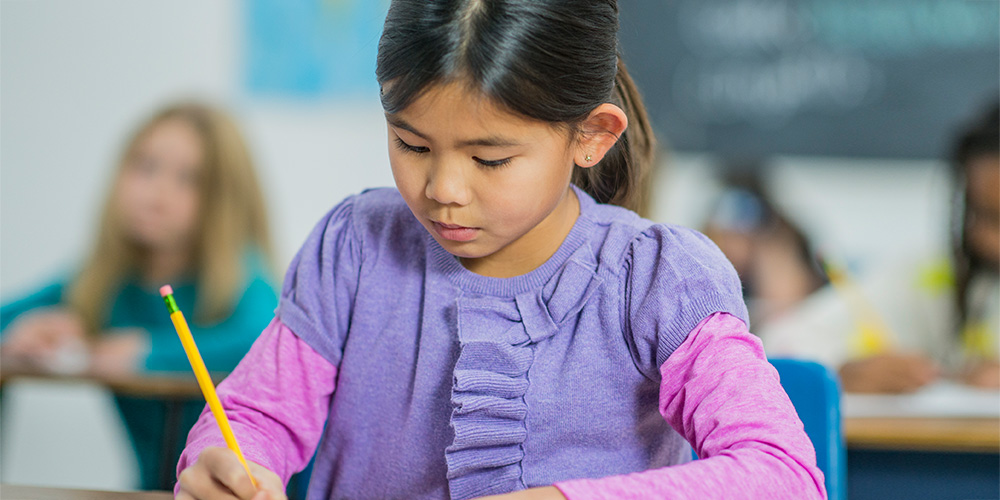Whether you’re a teacher or student, newbie or veteran, feedback is essential for growth. That’s why your school has consistent feedback loops in place, like grading for students and observations for teachers. But what happens when it’s time for students to give feedback—both to themselves and to you?
Many teachers cringe at the thought of giving students a formal voice through classroom surveys. After all, students can sometimes say things that aren’t helpful (and, indeed, can be hurtful). However, in the right setting, their thoughts can potentially help you get a better understanding of your classroom environment and find ways to improve it.
In this article, we’ll discuss how to lead students through self-evaluations and teaching assessments (also known as student perception surveys).
Student Self-Evaluations
Benefits
Unlike formative and summative assessments, self-evaluations help students step out of the heaviness of learning content and instead shift their focus to how they work and learn best. Wabisabi Learning describes the many benefits of self-evaluations and why they’re worth dedicating classroom time to:
- Responsibility: It’s easy for students to assume that learning is a passive process where the teacher tells them everything they need to know. Self-evaluations help students realize they are responsible for their learning too.
- Critical thinking: Critical thinking involves looking at different elements and making an informed judgment or analysis based on those observations. Self-evaluations are a fantastic exercise in critical thinking as students review their learning and determine how they can improve.
- Honesty: Students not being accountable is a problem in many classrooms across the country. Self-evaluations give students a judgment-free opportunity to review the amount of effort they’re putting into their learning, what they could do better, what they need help on, and more.
- Goal setting: It’s never too early to introduce students to the concept of goal setting. Self-evaluations can give students ideas for the types of goals they want to set and promote buy-in into the learning process as students work toward goals they set for themselves (instead of just goals you’ve set for them).
- Learning styles: Sometimes students struggle not because they’re undisciplined or untalented in an area, but simply because they don’t understand how they learn best. Self-evaluations can help students discover their individual learning style, so they can learn to leverage their strengths and offset weaknesses.
Best Practices
Dr. Jackie Gerstein offers an excellent template for student self-evaluations:
- Did I work as hard as I could have? If students didn’t do well, it’s important for them to recognize whether they’re having sincere difficulties with the content or if they didn’t put in the necessary effort.
- Did I set and maintain high standards for myself? It can be very impactful for students to acknowledge for themselves that they aren’t pursuing high standards, rather than you having to say it.
- Did I spend enough time doing quality work? It’s helpful for students to understand how much time different types of assignments take them so they can plan accordingly (e.g., one student might need to spend an hour to write a quality essay, while another might need to spend three hours).
- Did I regulate my procrastination, distractions, and temptations in order to complete my work? This question is a great opportunity for students to identify exactly what distracts them so they can plan to address it next time.
- Did I make good use of available resources? Sometimes students simply forget to consult the resources available to them, like their textbook, assignment instructions, or Internet search engines. This question will remind them not to become tunnel-visioned.
- Did I ask questions if I needed help? Some students are reluctant to ask questions even if they need to, or will put off questions until it’s too late. Asking this question will reinforce that it’s okay to ask for help.
- Did I review and re-review my work for possible errors? It’s tempting for students to turn in an assignment as soon as they finish, but this question will remind them of the importance of checking their work.
- Did I consider best practices for similar work? If you have a rubric or regular classroom expectations for an assignment, students should remember to consult it as they complete their work.
- Am I proud of my work? Would I share it with an audience outside my classroom? Sometimes thinking about a broader audience will inspire students to hold a higher standard for themselves.
Teaching Evaluations (Student Perception Surveys)
Pros and Cons
Feedback is tough under any circumstance, and in a stressful profession like teaching, it can be hard not to interpret critiques as “piling on” when you’re already giving it your all, day in and day out. However, most teachers agree that they can benefit from peers and coaches offering advice and feedback on their classroom practices.
But what about feedback from students?
If you just cringed a little, that’s okay. The experts are split on this issue too. Let’s look at some of the pros and cons of doing these types of surveys in your classroom.
The Cons
Many thought leaders believe students are not qualified to be fair evaluators of a teacher’s performance because they don’t know what’s expected of teachers on a professional level (e.g., knowledge of curriculum and pedagogy, classroom management best practices).
Moreover, in the Chronicle of Higher Education, Nancy Bunge points out that students can sometimes judge based on irrelevant issues such as physical appearance. Studies have also shown that there can be gender bias in the way students rate their teachers.
Finally, evaluations can set up a perverse incentive for teachers: Students who receive higher grades tend to give better evaluations, so even teachers with the highest integrity can be tempted to grade differently when they know students will be evaluating them later.
The Pros
In a 2015 report, the American Institutes for Research found that students may be more effective at rating teachers’ performance than we think. The report points out that unlike other evaluators, students are with their teachers every single day, so they have a unique perspective and more experience on what life is actually like in your classroom. In many ways, the data bear out this observation:
- Studies show that student ratings are consistent from year to year, meaning that on average students can consistently identify a teacher’s strengths and weaknesses.
- Studies also show that students rate different teachers at different levels (meaning that they don’t just give high or low ratings to all teachers regardless of performance), and that secondary students in particular can discriminate between effective and ineffective teachers.
- Finally, studies show that students can tell the difference between effective teaching practices and their interactions with teachers. In other words, they can like a teacher personally but give negative feedback on classroom practices, or vice versa.
Taken together, the data show that students’ feedback may actually be accurate to what’s going well or not in the classroom, so it can be useful to listen to what they have to say.
Best Practices
If you do decide to do teacher evaluations, it’s important to give students explicit direction on the type of feedback you’re looking for and the appropriate way to communicate it. Vanderbilt University offers the following advice on how to get the most out of student perception surveys:
- Prime the classroom. Let students know what the evaluation will entail, including who will be proctoring the evaluation (you or someone else), how to fill out the evaluation, how the evaluations will be kept anonymous, and who will be viewing the evaluations (you, your principal, etc.).
- Discuss the importance of honest, constructive feedback. Remind students that if they don’t share something, you won’t know about it! You’ve probably talked to them about the value of grades and feedback, but make sure to contextualize what that means for this exercise. If you can, give students examples of how you’ve changed classroom practices or other parts of your life based on feedback someone shared with you.
- Set the expectation that there will be positive and negative feedback. The word feedback can sometimes have a negative connotation to it, as if it only refers to constructive criticism. But remind students that feedback can be positive too; ask them to share what’s working well in the class, not just what they want to change.
- Highlight the feedback you find most useful. Make sure to provide examples of the types of information you’re looking for to get students’ gears turning, and ask students to provide specific examples as well. For example, tell students that instead of writing “I learn a lot,” it would be helpful if they provide details such as “I learn a lot when we do reading stations.”
Getting the right kind of feedback can be challenging, and hearing that feedback can be even more challenging. But at the end of it, you and your students will learn and grow in ways you wouldn’t be able to without classroom surveys.






